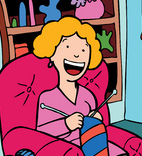Machine knitting fans are ecstatic about how fast their equipment can produce elaborate stitches. But even with speed and volume advantages, machine knitting can’t absolutely replace hand knitting. They are two totally different crafts and, often, you will need to do a combination of hand knitting, machine knitting and crochet trim to finish a project.
With a knitting machine, you can weave large pieces with knitting machine yarn in a short amount of time without inflicting your hand with carpal tunnel syndrome. Machine knitting brings out your creative side – blending delicate lace with fancy patterns in exotic color mixes that might otherwise be tough to achieve when knitting by hand. Machine knitting also provides you with hundreds of patterns to choose from, pre-installed with your equipment so you don’t have to browse through several shelves in a crafts shop. A Brother knitting machine has more than 500 pre-set pattern options.
Despite these benefits, there is a downside to machine knitting. And it’s important to know about these disadvantages before you fork over all that cash on a knitting machine. First of all, knitting machines are way too bulky to sit on your lap. They would take up a large amount of space in your house. Also, knitting machines require tons of spare time when setting up and learning their complicated features.
Knitting machines can mean a large investment of money. Brother knitting machines can cost around $500 or more, depending on how fancy the features are. A knitting machine works with only one weight class, so you will need a different knitting machine for each different yarn weight you will use, plus expensive special attachments for ribbing or working knit/purl mixes. A Silver Reed ribbing attachment goes for around $700, an Intarsia carriage for $90, and yarn changer for $300 – these are all added costs that could drive your costs through the roof.
Flexibility is one advantage that hand knitting has over machine knitting. You can increase or decrease as many stitches as you want in the middle of a row just as easily as the beginning or the end. But to do ribbing or purl stitches on a knitting machine, you have got to drop all of the stitches on the row that you need purled and work them back up again. You can see both sides of the pattern while you are hand knitting, but you can only see the purl side when you’re machine knitting, making it difficult to see how the final result would actually look like.
If you are still set on buying a knitting machine, try out several brands and models as you begin your search. Ask other machine knitters for recommendations or attend knitting seminars. Machine knitting chat groups online are also great sources of info when deciding on the appropriate knitting machine for you.



